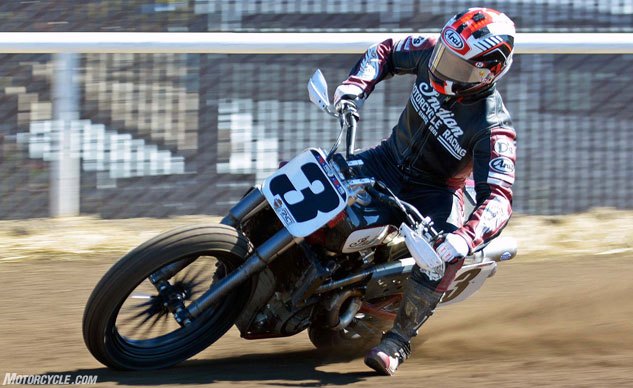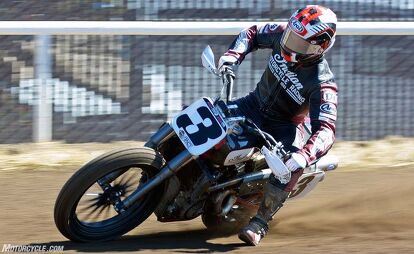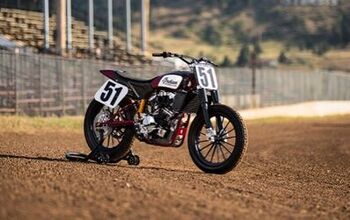Indian Scout FTR750 Ride Review
MO enlists Chris Carr to test ride Indian's new flat tracker!
Sometimes it seems as if the term “history was made” is overused to the point of cliché, but it’s about the only way to describe the competitive rollout of the all-new, purpose-built Indian Scout FTR750 flat-tracker at the series finale of the 2016 AMA Pro Flat Track Championship on September 25, 2016.
That day at the Ramspur Winery Santa Rosa Mile marked the first time in over 60 years that an Indian-branded motorcycle had turned a tire in AMA national flat track competition, and the first time in 63 years since Indian stood proudly atop the sport by winning back-to-back-to-back National Championship titles in 1951, ’52 and ’53. Back then, Indian seemed unstoppable, right up until the time that it was stopped, and it wasn’t the competition that did-in the mighty factory Indian Wrecking Crew of Bill Tuman, Bobby Hill and Ernie Beckman. It was Indian itself, which ceased production of its fabled road-going Chief and Scout models. Cue the sound of the plug being pulled on the jukebox here.
Indian’s turmoil and subsequent revival has been well-documented on MO’s pages, so no need to rehash the point that under Polaris leadership the Indian brand is strong again regardless of how much stock one wants to place in the disconnect between the original Springfield, Massachusetts-based Indian and the current version.
That last bit sure as heck doesn’t seem to bother the staunch Indian faithful and the old-timers who were part of the original effort, as evidenced by the Santa Rosa appearance of 1953 AMA National Champion Bill Tuman, the last man to ride an Indian to the pinnacle of the sport. Now 95, Tuman was on hand to witness history right alongside the rest of us as fellow former National Champion Joe Kopp climbed into Indian factory racing leathers, strapped on his steel shoe and entered the Scout FTR750 in its first competition.
“That thing is choice,” said Tuman, who was still winning big races on his Indian Scout well into 1955 because “that’s how good it was.”
“They [Indian Motorcycle] have done good,” Tuman added. “That (new) bike gets better every time they take it out on the track. I’m happy to see Indian back at the races, and I think they’re going to be here for a long time to come.”
Who wants to argue with that stamp of approval?
As Tuman suggested, for evidence of Indian’s strength, one needed to look no farther than the Santa Rosa Mile where Indian’s ground-up, purpose-built flat-track racer took to the track after just nine months of development. Nine months. That’s a short period of time to develop a single engine component, let alone a complete, full-blown, fire-breathing racing motorcycle, but as Indian Product Director for Motorcycles Gary Gray alludes, the company’s burning desire to return the brand to its roots made the seemingly impossible possible.
“We’ve always known that Indian was going to come back to flat track,” Gray said. “It’s part of our brand. It’s what made the company great. So, after launching the Chief lineup and the Scout lineup, it was time for Indian to get back to the track.”
Indian’s plan was far from long range, however. Gray said that once Indian Motorcycle V.P. Steve Meneto committed the company to racing in August of 2015, the plan was to have a fully developed motorcycle and a complete race program by the start of the 2017 season.
“After that, we said, ‘Well, we’d better get going,’” Gray said. “We started on the project in October of last year, and we started serious design work in December of last year. In less than a year, we’ve made it to Santa Rosa.”
And not with some cobbled-together, production Scout-based piece, either. Designed in conjunction with MotoGP engine manufacturer Swissauto, which Polaris owns, the Scout FTR750 engine combines traditional flat-track values with modern technology in a purpose-built racing package, effectively making it the only engine of its kind in the sport today.
Harley-Davidson’s benchmark XR750 is a legendary racing engine across all forms of motorsports, and it has relied on a sound design (and favorable rules… –Ed.) to see it through decades of dominance in flat track. The winningest flat-track engine of all-time, it has come under fire in recent years by production-based twins from Kawasaki, Suzuki and Ducati, mostly due to their ability to make power at over 10,000 rpm. Flat-track tuners have taken advantage of the potential of these interlopers, especially on the big mile tracks, developing them to negate the Harley’s ground-grabbing tractability in the corners by out-gunning them on the straights. Harley XR tuners have responded by turning the locomotive-like XR motors even faster, and the XR has managed to keep pace and continue to win series titles, but a spate of recent engine failures is making it clear that the air-cooled, two-valves-per-cylinder XRs may have reached their limit. Harley tuners we spoke to tell us that the mighty XR simply cannot reliably handle the stresses of the 9000+ rpm that is being asked of it nowadays.
The Indian Scout FTR750 was designed and built to be the best of both worlds, offering mid-corner grip and tractability while revving past 10,000 rpm for the sprints down the straightaways without even breaking a sweat. It’s a 53-degree V-Twin that achieves its rpm potential via a rather large 88mm bore and a short 61.5mm stroke that compares more closely to the numbers of the high-winding Kawasaki parallel-Twin than the Harley’s long-stroke 45-degree V-Twin. The Indian features double overhead cams and four valves per cylinder whereas the XR’s aforementioned two valves per cylinder are actuated via pushrods bumped by four single-lobe camshafts in the engine case.
Liquid-cooling and an efficient, modern cylinder head design allow the Indian to handle the extra heat generated by its 14.0:1 compression ratio, and more compression means more explosive downforce on the piston during the combustion cycle, which means more power so long as you can control the flame front during the burn. For the air-cooled, hemi-headed XR to be able to handle that kind of compression without detonating itself into a lump of molten alloy would probably require the use of methanol, a fuel that is banned in AMA Flat Track racing. Speaking of fuel, the Scout FTR750 is fuel-injected, breathing through a billet unit that houses two 38mm throttle bodies, and the bike’s ECU allows for incremental adjustments to the ignition to tailor the power delivery. The engine weighs 106 lbs., 44 less than an XR750, and it makes a reliable 110 horsepower. It is said to be capable of much more, but early testing convinced Indian to back it down a bit.
Even by flat track standards, the Scout FTR750 engine is the proverbial elephant that is a mouse built to military specifications. It very much appears to be the right tool for the job.
“We knew if we were going to do this, we couldn’t let the world down,” Gray said.
And they didn’t, at least not at Santa Rosa.
“We had reasonable expectations for our debut,” Gray said. “This was actually just a test weekend. We’ve been testing roughly since July, but our plan was always to get it on the track and test it against other bikes. You can do really well in testing when you’re the only bike on the track, but it doesn’t mean a lot until you get out there with other bikes and deal with the realities of racing. So our expectations were that just to make the main would be a victory and we would be happy.”
If that is true, then Indian was certainly happy with Kopp’s results in the second heat race of the day when he battled for the lead before settling into second place, earning a direct transfer to the main event and putting the Indian into the Dash for Cash, which also determines starting positions on the front row for the National main event.
“We were ecstatic, but then came the Dash for Cash, and we won it,” Gray said. “We were like, ‘This is incredible!’ At that point, we had zero expectations of winning the main, but then Joe launched off the line and led a lap. That was super-exciting for a guy who is a great rider but, in all fairness, has been out of the sport for a bit. So, you know, to finish seventh, we were over the moon.”
While falling just under our own over/under expectation that Kopp would finish sixth or better in the main event, it was hard not to be impressed with what we had seen. Despite being in great shape, the 48-year-old Kopp actually blamed himself—and not any shortcoming of the bike—for his result.
“I know I mixed it up in the Heat and in the Dash, but the intensity level is always higher in the main event,” Kopp said. “Bottom line is that I was walking out of here in one piece. The other guys were just pushing it to a limit that I wasn’t comfortable. I don’t want people to think that it was the bike. It was just me. Call it old-man syndrome. But I dug deep in the last five laps and got a couple guys back. The bike is awesome. Tractability, like when you pick up the throttle, it’s a lot like a Harley, but it ramps up quicker and it revs higher. The mid-range and top-end on this bike are phenomenal if you can keep it hooked up.”
We certainly respect Kopp’s expert opinion, but when Indian offered to let us take the bike for a spin on the Santa Rosa Mile the day after the race, we decided to enlist another rider with AMA Pro Flat Track Championship credentials, AMA Hall of Fame flat-track racer Chris Carr, whose seven series titles and 78 National wins rank him second all-time in both categories. We figured Carr, who spent most of his career aboard Harley-Davidson XR750s, could give us the perspective of someone not tied to the Indian development program.
Although he has seldom swung a leg over a 750cc twin since retiring from the series in 2011, it was clear that Carr still knows how to ride a V-Twin flat-tracker. The former champion had everyone’s attention as he gunned the Scout FTR750 around the chewed-up Santa Rosa Mile racetrack. We were given just two three-lap runs on the Scout, but Carr’s wealth of experience enabled him to download a mountain of feedback. That’s why we drafted him for the job in the first place!
“Seat-of-the-pants power feel is that from way down low all the way to the top of the rpm range, the bike is just solid, and it didn’t make me cringe,” Carr said. “It has a very, very linear powerband. When it gets into the cam, it gets into the cam in a very mellow fashion. It isn’t overly aggressive, and that’s what you need for dirt. A lot of people put major focus on peak horsepower and high rpm, but the reality is that in dirt track you spend a very short period of time at that peak, and it is usually after the start/finish line. What you need is something that can run up to that range and is manageable. For 100-horsepower motorcycles riding around on 75-horsepower tires, sometimes too much is too much. I didn’t feel like this bike has too much. It has just enough in the right places.”
To watch and listen to the Indian, you wouldn’t think that to be the case. The Scout FTR750s sharp, biting exhaust note ramped up so quickly when Carr got on the gas that it would lead you to believe that the bike’s rear tire spins uncontrollably. It doesn’t, says Carr, although even if it did, the Indian/Swissauto team designed the engine to incorporate external flywheels that can be swapped out to help tailor the engine’s hit and tractability as needed.
“No matter what, even when you spin up, it maintains a really good connection to the track,” he said. “That’s something that we as riders feel, and feel is something that you can’t teach. It is acquired over time. This bike felt like no matter how quickly it spun up, it wanted to stay hooked to the ground and go forward.”
One aspect of the bike that Carr wasn’t totally impressed with was the ratio selection for the top two gears in its four-speed transmission.
“Third and fourth gear are pretty far apart, just about as far apart as you would find in a standard off-road motorcycle transmission,” Carr said. “My suggestion to them is that you need to have third and fourth gear closer together, within a tooth or so, because on oval tracks you want to make half-tooth or sometimes quarter-tooth adjustments. Tuners will have a lot more options at a rider’s disposal if you have the third and fourth gear ratios about one tooth apart [as measured by the rear sprocket in the final drive] on the gear chart. It’s a matter of being able to fine-tune the gearing for changing conditions.”
Although track conditions weren’t ideal, Carr also offered good feedback on the Scout FTR750 chassis.
“We were on a very difficult racetrack, but the bike handled it with ease,” Carr said. “It feels a little stiff for me, but that was probably because I was evaluating it 80% rather than 100%. On an XR, you pretty much sit ‘down’ in the saddle. This bike feels tall, like you are sitting on top of a fence, but with the majority of today’s racers growing up on motocross-based bikes, this one feels right in between what a modern-day DTX bike and an old-school flat-tracker feel like. It feels narrower through the middle than an XR, although you still feel some of the exhaust system on the left side, but you don’t have to wrap a leg over a carburetor [on the right side] like you do on an XR.”
At the end of the day, Carr came away impressed with the Indian Scout FTR750, so we asked him to give it a numerical rating from one 10, 10 being excellent and one…well…one being a number we’re pretty sure nobody would affix to the Indian effort at this point.
“If I had to rate it, I could only to it based on the track conditions here, my level of fitness and my age, but I would give it a solid 8 of 10 right now,” Carr said. “But I would love to have ridden this bike 15 years ago on a racetrack that was better prepared. If so, that number would be higher.”
Still, that’s high praise from Carr, a dirt-track legend who, in our experience, has never been easily impressed. It tells us that Indian has a real weapon to aim toward the National Championship, and the company has already increased its odds of hitting the target by announcing plans to field an Indian Wrecking Crew for the new millennium. Months ago, the company had already confirmed that four-time National Champion Jared Mees would be an Indian factory pilot in 2017, but at the awards banquet on the evening after the race, it also made the stunning announcement that no less than two more champions would be joining him, 2013 champion Brad Baker and newly crowned 2016 champion Bryan Smith. Overnight, Indian went from a big question mark in 2017 to an odds-on favorite to claim its first national flat-track title since Tuman won it for Indian in 1953. According to Gray, this program isn’t some effort to dabble in the sport. Indian is coming full force.
“Every decision we’ve made, we’ve made to win. When we penciled out who we wanted, we couldn’t have written down any better names than them [Mees, Baker and Smith]. Frankly, though, they came to us. They saw what we were doing with the bike. They knew about the history. They knew how important flat track was to us. They wanted to be a part of it, and they said, ‘We can help you.’ We couldn’t have been happier to get those phone calls.”
As things turned out in Santa Rosa, the signing of Smith to the team means that Indian will already be wearing the number-one plate next season, something that was inevitable considering that the title battle came down to him and Mees. But Gray is the first to admit that while that’s a nice benefit, that plate will mean a lot more on an Indian when it has been earned.
“The prospect of winning a national championship is huge, and it’s obviously what we want to do,” Gray said. “We’re not naïve enough to think that we’re just going to go right out there and do it, but hard work, persistence and being prepared is what we’re going to be. We don’t think that we’re going to go out and win every race, but we want to put everything in place to give ourselves the best chance possible. We’ve got the best bike and the best riders, but we know the competition isn’t going to lay down. It’s all going to be decided on the racetrack, and we think that flat-track fans are going to be in for one hell of a season in 2017.”
No doubt, one way or another, more history will be made.
More by Scott Rousseau




























































Comments
Join the conversation
Looks like I need to download the flat track schedule. I doubt we'll ever see the Del Mar mile again but Santa Rosa isn't far away.
Having met Mr Tuman, Mr Hill, Joe Kopp and Chris Carr, I am so excited about Indian coming back into the sport I can barely contain myself. I am sure the rider the team Indian has put together will do it justice. Can't wait for Springfield!